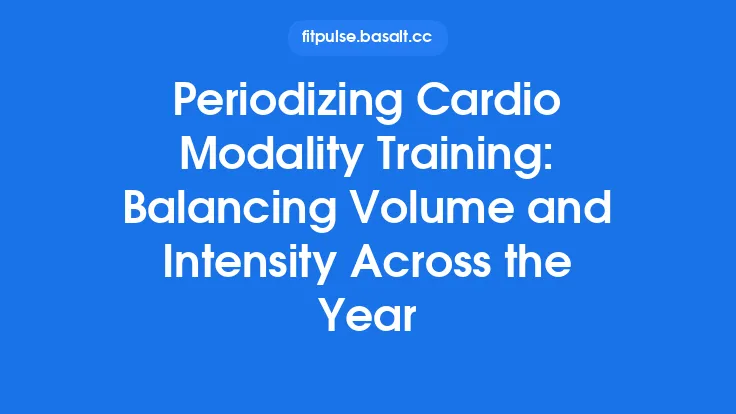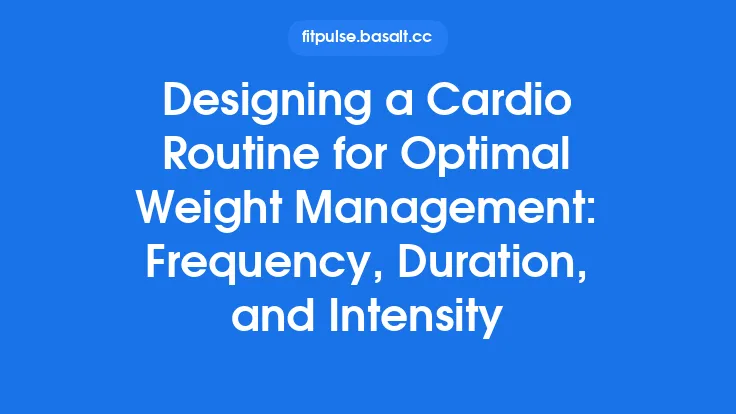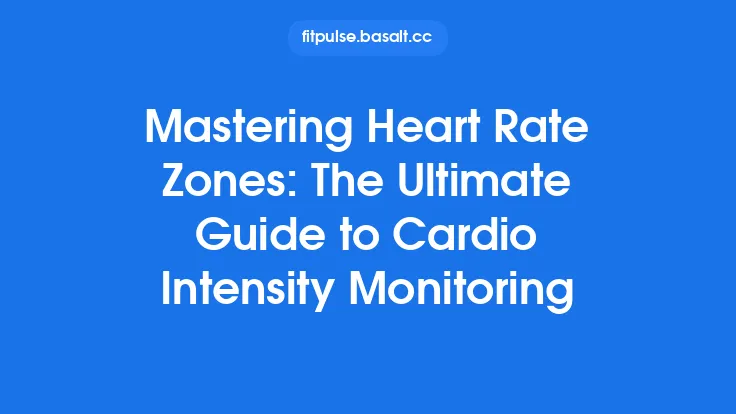Cardio periodization is often thought of in terms of long‑term calendars, specific training blocks, or the pursuit of a single goal such as performance or fat loss. While those elements are important, the core of any successful cardio program lies in the delicate balance between training volume (the total amount of work performed) and training intensity (the relative effort or speed at which that work is done). Striking the right equilibrium allows athletes and recreational exercisers alike to improve aerobic capacity, enhance metabolic efficiency, and reduce the risk of overuse injuries. This guide delves into the science and practicalities of balancing volume and intensity, offering evergreen strategies that can be applied across a wide range of cardio modalities—from running and cycling to rowing and swimming.
Understanding Volume and Intensity in Cardio Training
Training Volume
- Definition: The cumulative amount of work performed in a given period, typically expressed as total distance (kilometers or miles), total time (minutes or hours), or total energy expenditure (kilocalories).
- Key Metrics: Weekly mileage, session duration, total number of intervals, and cumulative heart‑rate‑based load (e.g., Training Impulse, or TRIMP).
Training Intensity
- Definition: The relative difficulty of a workout, often expressed as a percentage of maximal physiological markers such as VO₂max, lactate threshold, or maximal heart rate (HRmax).
- Key Metrics: Pace or power output relative to threshold, heart‑rate zones, perceived exertion (RPE), and blood lactate concentration.
Both variables are interdependent: increasing intensity typically reduces the amount of volume that can be sustained, while high volume often necessitates lower intensities to avoid excessive fatigue.
The Physiological Interplay Between Volume and Intensity
- Mitochondrial Adaptations
- Low‑to‑moderate intensity, high volume stimulates mitochondrial biogenesis through prolonged oxidative stress, enhancing the muscle’s ability to oxidize fat.
- High intensity, lower volume promotes rapid up‑regulation of enzymes involved in glycolysis and phosphocreatine recovery, improving the capacity for high‑rate energy production.
- Cardiac Remodeling
- Endurance‑type volume work (e.g., long, steady runs) encourages eccentric cardiac remodeling, increasing stroke volume and end‑diastolic dimensions.
- Intensity‑focused sessions (e.g., interval sprints) favor concentric adaptations, improving contractility and maximal cardiac output.
- Metabolic Flexibility
- A balanced approach trains the body to efficiently switch between fat and carbohydrate oxidation, a hallmark of well‑conditioned athletes.
- Neuromuscular Adaptations
- High‑intensity bursts improve motor unit recruitment patterns and neuromuscular coordination, while volume work reinforces movement economy and technique endurance.
Understanding these mechanisms helps practitioners decide where to place emphasis based on the athlete’s current profile and long‑term objectives.
Core Principles for Balancing Volume and Intensity
| Principle | Practical Implication |
|---|---|
| Progressive Equilibrium | Gradually increase either volume or intensity, but never both simultaneously beyond the athlete’s recovery capacity. |
| Specificity with Variation | Align the dominant stimulus (volume vs. intensity) with the target adaptation, but intersperse the opposite stimulus to maintain overall balance. |
| Individualization | Use baseline testing (e.g., VO₂max, lactate threshold) and ongoing monitoring to set personalized intensity zones and volume caps. |
| Periodicity of Stress | Alternate days or weeks of higher volume with days or weeks of higher intensity to allow systemic recovery while still providing a training stimulus. |
| Recovery Integration | Even without dedicated “recovery weeks,” embed low‑intensity, low‑volume sessions (active recovery) to facilitate adaptation. |
Designing a Balanced Cardio Block
- Establish Baseline Metrics
- Conduct a submaximal test to determine heart‑rate zones or a field test (e.g., 5‑km time trial) to estimate lactate threshold.
- Record typical weekly volume (e.g., total minutes or distance) over the past 4–6 weeks.
- Set a Target Ratio
- A common starting point for many athletes is 70 % volume / 30 % intensity (by time). This means that 70 % of training time is spent in low‑to‑moderate zones (Zone 1–2), while 30 % is allocated to higher zones (Zone 3–5). Adjust the ratio based on goals: endurance‑focused athletes may favor a higher volume proportion, whereas those seeking speed or power may shift toward more intensity.
- Allocate Sessions
- Low‑Intensity Volume Days: 45–90 min at 60–70 % HRmax (Zone 1–2).
- Moderate‑Intensity Steady Days: 30–60 min at 70–80 % HRmax (Zone 3).
- High‑Intensity Sessions: 20–40 min total work, broken into intervals (e.g., 4 × 4 min at 90–95 % HRmax with equal rest).
- Distribute Across the Week
- Example 7‑day layout:
- Mon – Low‑Intensity Volume
- Tue – Moderate‑Intensity Steady
- Wed – High‑Intensity Intervals
- Thu – Low‑Intensity Volume (active recovery)
- Fri – Moderate‑Intensity Steady
- Sat – Long Volume (extended low‑intensity)
- Sun – Rest or very light activity
- Adjust for Lifestyle Factors
- If training frequency is limited, compress volume into a single longer session and maintain intensity on a separate day, ensuring at least 48 h between high‑intensity efforts.
Tools for Quantifying Volume and Intensity
- Heart‑Rate Monitoring: Provides real‑time zone classification; calculate TRIMP by multiplying duration by zone weight.
- Power Meters (Cycling, Rowing): Offer objective intensity data independent of heart‑rate variability.
- GPS & Pace Sensors: Useful for distance‑based volume tracking and pace‑zone determination.
- Wearable Metabolic Estimators: Some devices estimate VO₂ and lactate threshold on the fly, allowing dynamic intensity adjustments.
- Training Logs & Software: Platforms like TrainingPeaks or Strava enable visual representation of volume‑intensity distribution over weeks.
Adjusting the Balance Over Time
- Re‑assessment Every 4–6 Weeks
- Perform a short field test (e.g., 3‑km time trial) to gauge changes in threshold and adjust intensity zones accordingly.
- Volume Tapering Before High‑Intensity Peaks
- Reduce total volume by 15–20 % while maintaining or slightly increasing intensity to sharpen performance without accumulating fatigue.
- Intensity Cycling
- Alternate “intensity‑focused” micro‑blocks (e.g., 2 weeks of higher interval density) with “volume‑focused” blocks (e.g., 2 weeks of longer steady rides).
- Feedback‑Driven Tweaks
- Use subjective measures (RPE, sleep quality, mood) alongside objective data to fine‑tune the ratio. If fatigue markers rise, consider shifting a high‑intensity day to a lower‑intensity volume day.
Monitoring and Feedback Mechanisms
- Physiological Markers: Resting heart‑rate trends, HRV (heart‑rate variability), and morning cortisol levels can signal systemic stress.
- Performance Indicators: Changes in time‑to‑exhaustion at a set intensity, or improvements in threshold pace, reflect successful adaptation.
- Subjective Scales: The Borg RPE scale, the Recovery-Stress Questionnaire, and simple “energy” ratings provide quick daily checks.
- Injury Surveillance: Track any recurring aches, joint pain, or overuse symptoms; a spike often indicates an imbalance skewed toward excessive volume or intensity.
Common Mistakes and How to Avoid Them
| Mistake | Why It Happens | Remedy |
|---|---|---|
| Overloading Both Volume and Intensity Simultaneously | Desire for rapid gains or misinterpretation of “harder is better.” | Follow the progressive equilibrium principle; increase one variable at a time. |
| Neglecting Low‑Intensity Work | Belief that only high‑intensity sessions drive fitness. | Preserve at least 60 % of weekly time in low‑intensity zones to support aerobic base and recovery. |
| Using Fixed Ratios for All Athletes | One‑size‑fits‑all mindset. | Customize the volume‑intensity ratio based on individual testing, training history, and goals. |
| Ignoring Fatigue Signals | Overreliance on objective data without subjective context. | Incorporate daily RPE and sleep quality checks; adjust the upcoming session accordingly. |
| Misclassifying Intensity Zones | Outdated max‑heart‑rate formulas (e.g., 220‑age) leading to inaccurate zones. | Derive zones from field or lab testing (lactate threshold, ventilatory threshold) for greater precision. |
Practical Example of a Balanced Cardio Cycle
Athlete Profile
- 28‑year‑old recreational runner with a recent 10 km time of 48 min.
- Goal: Improve race performance while maintaining overall health.
Baseline Data
- HRmax: 190 bpm (lab test)
- Lactate threshold HR: 165 bpm (≈87 % HRmax)
Chosen Ratio: 65 % volume / 35 % intensity (by time)
| Day | Session | Duration | Intensity (HR Zone) | Focus |
|---|---|---|---|---|
| Mon | Easy Run | 60 min | 115–130 bpm (Zone 1) | Aerobic base |
| Tue | Tempo Run | 40 min total (including warm‑up) | 150–165 bpm (Zone 3) | Threshold work |
| Wed | Interval Session | 30 min total work (8 × 2 min) | 175–185 bpm (Zone 5) | VO₂max stimulus |
| Thu | Recovery Jog | 45 min | 110–120 bpm (Zone 1) | Active recovery |
| Fri | Moderate Run | 50 min | 135–150 bpm (Zone 2) | Volume maintenance |
| Sat | Long Run | 90 min | 115–130 bpm (Zone 1) | Endurance volume |
| Sun | Rest or Light Cross‑Train | — | — | Full recovery |
Progression Over 4 Weeks
- Weeks 1‑2: Maintain volume, increase interval intensity by 5 % HR.
- Weeks 3‑4: Add 10 % more volume to the long run, keep interval intensity constant.
Outcome Measures
- Re‑test 10 km at week 5; expect a 2–3 % improvement if balance is maintained.
- Monitor resting HR; a drop of 3–5 bpm indicates positive adaptation.
Bringing It All Together
Balancing volume and intensity is less about rigid formulas and more about creating a dynamic dialogue between the body’s stressors and its recovery capacity. By:
- Quantifying both variables with reliable tools,
- Setting a personalized ratio that reflects current fitness and goals,
- Structuring weekly sessions to alternate stress types, and
- Continuously monitoring physiological and subjective feedback,
athletes can enjoy steady, sustainable improvements in cardiovascular conditioning. This approach not only enhances performance metrics such as VO₂max and lactate threshold but also promotes long‑term health by minimizing overuse injuries and burnout. Whether you’re preparing for a marathon, sharpening your sprint capacity, or simply aiming for a healthier heart, mastering the balance between volume and intensity is the cornerstone of effective cardio periodization.





